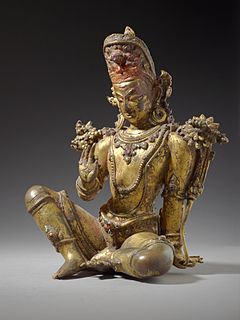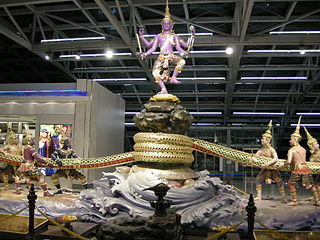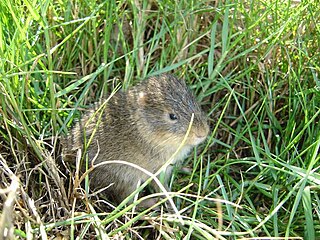
Asuras are a class of beings or power-seeking clans related to the more benevolent Devas in Hinduism.
Hindu deities are the gods and goddesses in Hinduism. The terms and epithets for deity within the diverse traditions of Hinduism vary, and include Deva, Devi, Ishvara, Ishvari, Bhagavān and Bhagavati.

Kurma, also known as 'KurmaRaja' is an avatar of the Hindu god Vishnu. Originating in Vedic literature such as the YajurVeda as being synonymous with the Saptarishi called Kasyapa, Kurma is most commonly associated in post-Vedic literature such as the Puranas with the legend of the churning of the Ocean of Milk, referred to as the Samudra manthan. Also synonymous with Akupara, the world-turtle supporting the Earth, Kurma is listed as the second incarnation of the Dashavatara, the ten principal avatars of Vishnu.
Intermedia was a term originally coined by John Brockman and used in the mid-1960s by Fluxus artist Dick Higgins to describe various inter-disciplinary art activities that occurred between genres in the 1960s.

The intermediate egret, median egret, smaller egret, or yellow-billed egret is a medium-sized heron. Some taxonomists put the species in the genus Egretta or Mesophoyx. It is a resident breeder from east Africa across the Indian subcontinent to Southeast Asia and Australia.

Deva means "heavenly, divine, anything of excellence", and is also one of the terms for a deity in Hinduism. Deva is a masculine term; the feminine equivalent is Devi.

Mahishasura was a buffalo Asura in Hinduism. He is known among Hindus of most sects as a deceitful demon who pursued his evil ways by shape-shifting. Mahishasura was the son of Rambha, and the great-grandson of Brahmarshi Kashyapa. He was ultimately killed by Goddess Durga - after which She gained the epithet Mahishasuramardini. The Navaratri festival eulogizes this battle between Mahishasura and Durga, culminating in Vijaya Dasami, a celebration of his ultimate defeat. This story of the "triumph of Good over Evil" carries profound symbolism in Hinduism, particularly Shaktism, and is both narrated as well as reenacted from the Devi Mahatmya at many South- and Southeast Asian Hindu temples. The story is also told in the Sikh text Chandi di Var, also called Var Durga Di, which many in Sikh tradition believe was included in the Dasam Granth by Guru Gobind Singh.

A daeva is a Zoroastrian supernatural entity with disagreeable characteristics. In the Gathas, the oldest texts of the Zoroastrian canon, the daevas are "gods that are rejected". This meaning is – subject to interpretation – perhaps also evident in the Old Persian "daiva inscription" of the 5th century BCE. In the Younger Avesta, the daevas are divinities that promote chaos and disorder. In later tradition and folklore, the dēws are personifications of every imaginable evil.

The Samudra Manthana is one of the best-known episodes in the Hindu philosophy narrated in the Bhagavata Purana, in the Mahabharata and in the Vishnu Purana. The Samudra Manthana explains the origin of Amrita, the nectar of immortality and the omnipotent god of destruction Shiva drank the vish.

An asura in Buddhism is a demigod or titan of the Kāmadhātu. They are described as having three heads with three faces each and either four or six arms.

The lesser siren is a species of aquatic salamander native to the eastern United States and northern Mexico. They are referred to by numerous common names, including two-legged eel, dwarf siren, and mud eel. The specific epithet intermedia denotes their intermediate size, between the greater siren, Siren lacertina, and the dwarf sirens, Pseudobranchus species.

Santa Catarina's guinea pig or Moleques do Sul cavy is a rare guinea pig species of southeastern South America.
The Kālakeyas or Kālakhañjas are a class of Asura in Hindu mythology. They were a powerful, ferocious and cruel clan of the Dānavas.

The small woolly bat is a species of vesper bat in the family Vespertilionidae. It is found only in Malaysia and is little known. It is only slightly larger than the Kitti's hog-nosed bat, one of the smallest mammals in the world. The small woolly bat weighs 2.5 to 4 g.

Asura is a genus of moths in the subfamily Arctiinae erected by Francis Walker in 1854.

Asura's Wrath is an action video game developed by CyberConnect2 and published by Capcom. Asura's Wrath was first announced at the Tokyo Game Show in 2010, and was released worldwide in February 2012. The game is playable on PlayStation 3, Xbox 360, Xbox One via 360 backwards compatibility, and the PlayStation 4 and PC via PlayStation Now.

Cyme sexualis is a moth of the subfamily Arctiinae first described by Felder in 1864. It is found on Ambon, Sulawesi, the Dampier Archipelago. and in New Guinea.
Peripatopsis intermedia is a species of velvet worm in the Peripatopsidae family. The type locality is in South Africa.
Ulmus × intermediaElowsky is a natural hybrid elm occurring across Nebraska and several other Midwestern states, derived from the crossing of Ulmus rubra and Ulmus pumila. As Red Elm U. rubra is far less fertile, and highly susceptible to Dutch elm disease (:DED), it could eventually be hybridized out of existence by U. × intermedia. The hybrid was first reported from the wild in the Chicago region in 1950 and was provisionally named U. × nothaWilhelm & Ware in 1994.
The División Intermedia, the second division of Peruvian football (soccer) in 1984 until 1987. The tournament was played on a home-and-away round-robin basis.












